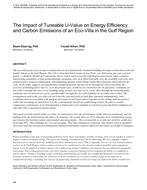Description
The eco-villa project was set up to evaluate the use of a dynamically insulated building envelope construction in the hot humid climate of the Gulf Region. The villa, a detached family home on two floors, was built using pre-cast concrete panels – a Modern Method of Construction that is widely used across the Gulf Region and in many other countries. Interlocking assemblies of type permeodynamic insulation cells were fitted internally over the available wall area and sealed in place using an independent, self-supporting gypsum board lining system that contained and protected the cells. As the name suggests, permeodynamic insulation permits the flow of air through the cells to facilitate the recovery of building fabric heat or, as in the present case, coolth loss to ventilation air. In operation, ventilation air has to flow through the rain screen cladding using an inlet vent into an air cavity, then through the permeodynamic insulation into an internal air cavity, and thereafter through the dry wall cladding via an outlet vent or duct. The arrangement used in the eco-villa was such that the external walls of each floor operated independently. Inlet ventilation louvers were fitted with integral sand traps to wall faces and a ring-duct in the ceiling void was used to collect the incoming air and deliver it to the roof-mounted central air conditioning system. In order to enable comparative performance to be benchmarked, a bypass duct was installed at roof level to provide fresh ventilation air when the villa is operated in bypass-mode.
This paper presents details of the eco-villa, its construction, how the performance of the villa was monitored, and the findings from the initial monitoring phase. In summary, the results show an 18% reduction in air conditioning energy use between the baseline (static) and dynamic operating modes. This corresponds to a reduction in fabric coolth loss of around 50%. These findings are very encouraging. They have enabled us to identify what further work is needed to show how both the construction method and thermal performance could be improved and made accessible to designers
Citation: First International Conference on Energy and Indoor Environment for Hot Climates, Doha, Qatar, February 2014
Product Details
- Published:
- 2014
- Number of Pages:
- 8
- File Size:
- 1 file , 4.2 MB
- Product Code(s):
- D-2014FICEConf-14-1




